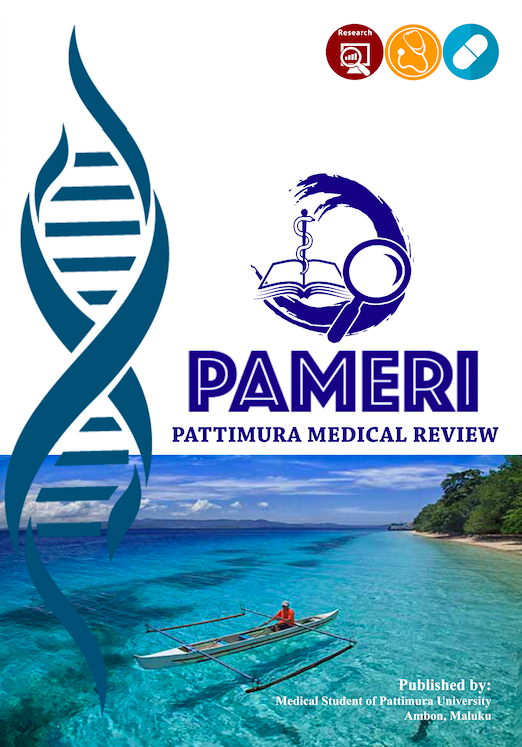HUBUNGAN PANJANG PENIS DENGAN INDEKS MASSA TUBUH PADA ANAK USIA 6-8 TAHUN
Abstract
Penis that has a short size will be a problem for parents. Usually the size of the penis is associated with obesity and considered that the size of the penis will become normal again after losing weight, therefore this study aims to determine whether there is a relationship of penis length with body mass index in children aged 6-8 years old in elementary school in Sirimau sub-district. The approach used in this research is cross-sectional conducted in SD Xaverius C, SD Kalam Kudus and SD Negeri 93 Ambon in June-August 2017. The number of respondents in this study are 85 children taken by consecutive sampling technique. Penis length is measured using "fully stretched length measurment measurements", while nutritional status measured by body mass index. The bivariate analysis used in this study is Kruskal Wallis test. The highest percentage of subjects with a normal penile length was found in subjects with normal nutrient status (86.4%). The highest percentage of subjects with small penis size were found in groups with very slim nutritional status (33%), and almost all subjects (95%) with micropenis had excess nutrient status (obese).Based on the results of bivariate analysis, there was a significant relationship between penile length and body mass index (p <0.001).
Downloads
References
Kelch RP. Disorder of pubertal maturation. In: Rudolph AM, Hoffman JIE, Rudolph CD. (eds.) Rudolph’s pediatrics. Ed 20. Stamford: Lange & Appleton; 1996. p.1803.
Supriyatno, Siregar C. Mikropenis. Jurnal Sari Pediatri. 2004;5:145-9.
Supriyatno, Hakimi, Siregar C. Prevalensi mikropenis pada murid taman kanak-kanak. Jurnal Sari Pediatri. 2004;6:115-8.
Batubara JRL. Mikropenis. Kongres Nasional Ilmu Kesehatan Anak XI. Jakarta; 1999.
Tridjaja, Batubara JRL, Pulungan A. Pengobatan testosteron pada mikropenis. Jurnal Sari Pediatri. 2002;4:63-6.
Basuki S, Julia M, Machfudz S. Kejadian mikropenis pada anak obes. Jurnal Gizi Klinik Indonesia. 2009;6:8-12.
Ponchietti R, Mondaini N, Bonafè M, Di Loro F, Biscioni S, Masieri L. Penile length and circumference: a study on 3,300 young Italian males. Eur Urol. 2001;39:183-6.
Çamurdan A, Mustafa OÖ, Mustafa N, Ilhan, Orhun M, Çamurdan FS, dkk. Current stretched penile length: crosssectional study of 1040 healthy Turkish children aged 0 to 5 years. Eur Urol. 2007;70:572–5.
Sartika RAD. Faktor risiko obesitas pada anak 5-15 tahun di Indonesia. Makara, Kesehatan. 2011;15(1):33-34
Amin TT, Al-Sultan, Ali A. Overweight ang obesity and their relation to dietary habits and socio-demographic characteristic among male primary school children in Al-Hasa, kingdom of Saudi rabia. European journal of nutrition. 2008;47(6):310-18.
Mejia AMA, Longarce MR, Gibson JJ, Children with a tv in their bedroomat higher risk of being overweight. International journal of obesity. 2007;31:644-51.
Husmann DA, Cain MP. Microphalus phallic size is dependent on the timing of androgen administration. J Urol. 1994; 152:734-9.
Indrawan DK, Suryawan B, Sidiartha L, Arimbawa. Korelasi Panjang Penis Dengan Antropometri Anak Usia 5 Tahun. Bag/SMF Ilmu Kesehatan Anak Fakultas Kedokteran Udayana/Rumah Sakit Umum Pusat Sanglah Denpasar. 2012
Boas M, Boisen KA, Virtanen HE. Postnatal penile length and growth rate correlate to serum testosterone levels: a longitudinal study of 1962 normal boys. Eur J Endocrinol 2006; 154: 125- 129.
Copyright (c) 2019 PAMERI - Pattimura Medical Review

This work is licensed under a Creative Commons Attribution-NonCommercial-ShareAlike 4.0 International License.










